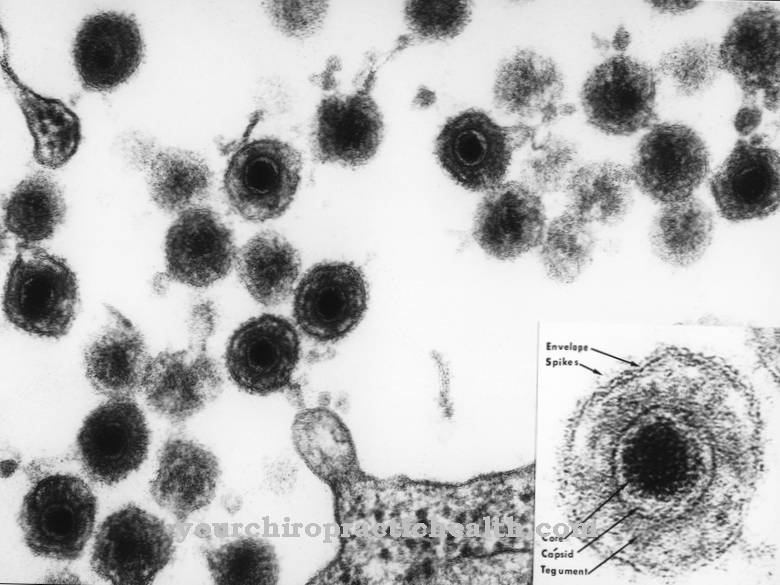Retroviruses have influenced the human genome for millions of years. But important infectious diseases can also be traced back to retroviruses.
What are retroviruses?
A virus is an infectious particle that is incapable of multiplying by itself. Viruses do not have their own metabolism either. Therefore viruses are not counted among the living beings, although they have individual characteristics of life.
A Retrovirus is a virus without its own DNA (deoxyribonucleic acid), a molecule that occurs in all living things and some viruses, which consists of a double helix and contains all hereditary information.
The genetic material (genome) of the retroviruses, which have a diameter of around 100 nm, on the other hand, contains only one strand of RNA (ribonucleic acid), which is surrounded by a package (“capsid”) made of proteins. The outer shell of the retroviruses is made up of largely water-insoluble molecules (made of "lipid" substances) in which virus proteins are embedded.
Meaning & function
“Endogenous retroviruses” (“XRV”) were integrated into the genome of a host cell in the germline of the host organism many generations ago (“provirus”) and are passed on from generation to generation.
Research has shown that approximately 9 percent of the human genome is made up of viral RNA. The vast majority of this RNA was found in the genome of our ancestors an estimated 40 to 70 million years ago. Sub-components of retroviruses still recognizable in the human genome became part of the genetic make-up 100 million years ago. The genomes of some endogenous retroviruses even have a protective function for life: For example, human pregnancies are only possible because a certain ancient retrovirus prevents the rejection of the embryo.
In contrast, "exogenous retroviruses" ("ERV") penetrate the host organism through infection. Retroviruses, which infect vertebrates in particular, attack certain animal body cells that they specialize in. Within the cell they have infected, they incorporate their genetic material into the host cell's genetic material. After retroviruses have reproduced within the host cell, the viruses are released into the bloodstream and can thus infect other cells. The DNA of a cell is responsible for the production of RNA, which itself functions as part of the genome and, as a “messenger RNA” (mRNA, messenger RNA), transmits information that is necessary for the formation of proteins.
The term “retrovirus” results from the fact that this virus form reverses the initial experience of RNA formation within a cell: It is not the original DNA of the host cell that now triggers the instructions for RNA formation. Rather, the retrovirus changes the host cell's DNA, which, after infection, gives instructions for the production of new retroviruses. The so-called "reverse transcriptase" (RT), a special "enzyme" of the retrovirus, enables the retrovirus RNA to be introduced into the DNA of the host cell. Enzymes are substances that can trigger certain biochemical reactions.
Dangers, disorders, risks & diseases
The best known retrovirus is the HI virus (human immunodeficiency virus), which causes immune deficiency in humans. HIV specializes in so-called “T helper cells” (also called “CD4 lymphocytes”), which are responsible for coordinating the human body's defense against pathogens and foreign substances.
Lymphocytes belong to the group of white blood cells ("leukocytes"). T-helper cells represent a subgroup of “T cells”. The term “T cell” refers to the “thymus”, which is part of the so-called “lymphatic system” and thus the immune system. The thymus is an organ composed of two lobes that is located above the heart in humans. The "T cells" ("T lymphocytes") generated in the bone marrow and migrating from there to the thymus are responsible for the immune defense after they have matured in the thymus.
34 million people worldwide have become infected with the HIV virus. SIV (simian immunodeficiency virus) is a group of viruses from which HIV is believed to have developed. "Simian" means "ape-like" and refers to the carriers of the SIV. The HTLV-1 virus (human T-lymphotropic virus 1), which also affects the CD4 T lymphocytes in humans and related primates, is one of the retroviruses. A small number of infected people develop neurological diseases such as "tropical spastic paraparesis" or "T-cell leukemia".
The symptoms of tropical spastic paraparesis are similar to multiple sclerosis. T-cell leukemia leads to malignant (“malignant”) tumors that originate from the lymphocytes. The infection rate with the HTLV-1 virus is low in Europe: In Western Europe, 6,000 people are thought to be infected, around one percent of whom develop tropical spastic paraparesis. However, it is estimated that up to 20 million people have been infected with HTLV-1 worldwide.
The weakening of the immune system by reducing the number of T cells leads to an increased susceptibility to infections. The fight against diseases caused by retroviruses is made more difficult by a high mutation rate: a retrovirus mutation occurs with every thousandth to ten thousandth reverse transcriptase. The development of drugs for the treatment of retroviral diseases is primarily aimed at influencing reverse transcriptase.

























.jpg)


